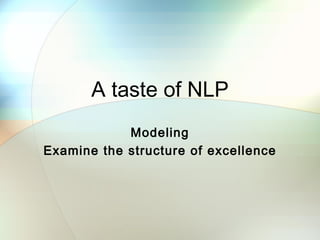
A Taste Of NLP in Modeling
- 1. A taste of NLP Modeling Examine the structure of excellence
- 5. People with excellent spelling tend to visualise the words as they spell them. Visual Remember
- 11. Unconscious Incompetence Conscious Incompetence Conscious Competence Unconscious Competence
Editor's Notes
- What is NLP? Neuro – understanding how the brain works Linguistic – the study of language structures Programming – how the brain learns Over all NLP brings together knowledge, skills and attitudes (or beliefs) from a variety of academic disciplines. And then makes them work… NLP is about understanding the structure of thoughts NLP is an applied psychology NLP is about describing and modeling excellence
- The word model has a number of related meanings. These are four of the thirteen definitions I found in the Collins Dictionary. A model can be a physical or theoretical way of describing or representing something. It can also be and example a pattern or an outstanding example.
- What would you like to model? What can you be an example of? What would you like to develop excellence in?
- Teaching or learning excellence involves two sides of the same process: Find the example of excellence Analyse what make this work Practice Review Adjust Keep going until you have achieved your goal.
- There is some evidence that people who have excellent spelling tend to visualise the words as they spell them.
- NLP is about the STRUCTURE of our thinking. Input is through our senses We also store and retrieve thoughts and memories in relation to our senses. Our mood or state is a result of our thoughts. If we can identify the state we wish to be in by looking at it’s structure, we can become more of who we wish to be. Imagine being able to feel confident and full of energy whenever you needed to.
- Look at the details of the structure – For example a colour movie with sound is usually a more powerful memory or thought than a black and white photograph.
- Auditory thoughts and memories can be very powerful – think about the way that music can affect your mood.
- Think about how you feel when you are with the people you love. Emotions are called feelings because they often have a physical effect. Think about when you were a teenager and someone embarrassed you – your circulation responded and opened the capillaries in your face making you hot and your face red.
- Exercise 1 Teaching and learning excellence. In pairs. Person One is to think about something they do well and describe: What do you see? What do you hear? What do you feel? While they are doing this thing. Person Two is to try to learn how to do this by reproducing what Person One does. At the signal swap places so that Person Two becomes the teacher and Person One becomes the learner.
- And this model shows STAGES of learning. Before we start we don’t know what we don’t know and this doesn’t worry us, we are unconscious of our incompetence. As we start to learn we realise what we don’t know and can’t do. This is an uncomfortable stage in the learning process and we need to give support to our learners (or ourselves) at this stage. As we practice we become more competent but we are still aware of our performance – conscious competence. Finally we automatically use our skills and knowledge, our competence, without any conscious thought.